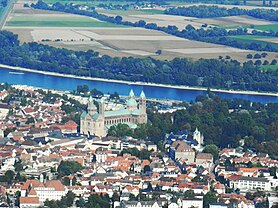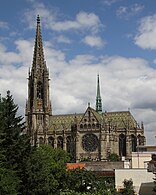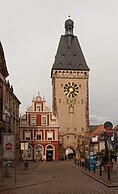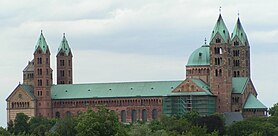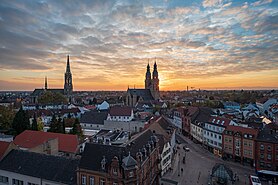
Back Speyer Afrikaans Speyer ALS ስፓየር Amharic Espira (Alemanya) AN شباير Arabic اشپیر AZB Шпайер Bashkir Шпаер Byelorussian Шпаер BE-X-OLD Шпайер Bulgarian
Speyer
Schbaija (Palatine German) | |
|---|---|
| Coordinates: 49°19′10″N 8°25′52″E / 49.31944°N 8.43111°E | |
| Country | Germany |
| State | Rhineland-Palatinate |
| District | Urban district |
| Subdivisions | 4 Stadtteile |
| Government | |
| • Lord mayor (2018–26) | Stefanie Seiler[1] (SPD) |
| Area | |
• Total | 42.58 km2 (16.44 sq mi) |
| Elevation | 92 m (302 ft) |
| Population (2022-12-31)[2] | |
• Total | 51,368 |
| • Density | 1,200/km2 (3,100/sq mi) |
| Time zone | UTC+01:00 (CET) |
| • Summer (DST) | UTC+02:00 (CEST) |
| Postal codes | 67346 |
| Dialling codes | 06232 |
| Vehicle registration | SP |
| Website | speyer |
Speyer (German: [ˈʃpaɪɐ] , older spelling Speier; Palatine German: Schbaija; French: Spire), historically known in English as Spires, is a city in Rhineland-Palatinate in the western part of the Federal Republic of Germany with approximately 50,000 inhabitants. Located on the left bank of the river Rhine, Speyer lies 25 km (16 miles) south of Ludwigshafen and Mannheim, and 21 km (13 miles) south-west of Heidelberg. Founded by the ancient Romans as an fortified town on the northeast frontiers of their Roman Empire, it is one of Germany's oldest cities. Speyer Cathedral, a number of other churches, and the Altpörtel ("old gate") dominate the Speyer landscape. In the cathedral, beneath the high altar, are the tombs of eight Holy Roman Emperors and German kings.
The city is famous for the 1529 Protestation at Speyer. One of the ShUM-cities which formed the cultural center of Jewish life in Europe during the Medieval / Middle Ages, Speyer and its Jewish courtyard was inscribed on the UNESCO (United Nations Educational, Scientific and Cultural Organization) World Heritage List in 2021.[3]
- ^ Wahl der Oberbürgermeister der kreisfreien Städte, Landeswahlleiter Rheinland-Pfalz, accessed 30 July 2021.
- ^ "Bevölkerungsstand 2022, Kreise, Gemeinden, Verbandsgemeinden" (PDF) (in German). Statistisches Landesamt Rheinland-Pfalz. 2023.
- ^ "ShUM Sites of Speyer, Worms and Mainz". UNESCO World Heritage Centre. United Nations Educational, Scientific, and Cultural Organization. Retrieved 8 October 2022.
